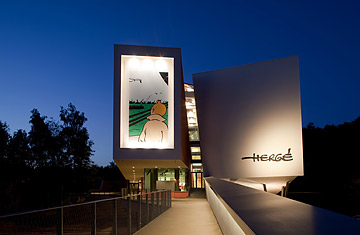
Entrance to the new Hergé Museum in Louvain-la-Neuve, Belgium.
(2 of 2)
There is also a gallery devoted to the science of Tintin, with scale models of cartoon inventions like Professor Calculus' glorious red-and-white moon rocket; another holds examples of imaginative merchandising that Hergé himself oversaw. Together, the displays are a testament to what Michael Farr, author of Tintin: The Complete Companion, describes as Tintin's timeless appeal: "Tintin is universal. He transcends fashion, age and nationality. These are classic, inexhaustible stories, beautifully drawn, beautifully written."
Tintin fans will rejoice in finally having a permanent tribute to Hergé's creation. And the new Magritte Museum in Brussels was also long overdue, says Charly Herscovici, head of the Magritte Foundation: "Brussels needs a Magritte museum just like Paris has a Picasso museum and Amsterdam a Van Gogh museum." Housed in the prim, neoclassical Hotel Altenloh just a stone's throw from the Royal Palace, the Magritte Museum is part of the complex of buildings that comprise Belgium's Royal Museums of Fine Art. But the sober-minded setting is something of a deception: echoing the artist's mischievous streak, the museum's windows have been replaced by realistic paintings of plump clouds against a blue sky.
Inside, the space has been completely remodeled to accommodate the 200 Magritte items on display: paintings, drawings, gouaches, posters, advertising art, letters, photographs, sculptures and films. It cost $10 million to build, most of that paid by Franco-Belgian energy giant GDF Suez, which is using the museum as a laboratory of green technologies like LED lights and climate-control systems.
Unlike Hergé, Magritte was a late bloomer. Born in 1898, his artistic talents initially led him into wallpaper design and advertising (a field in which Hergé briefly moonlighted too). It wasn't until 1945 that he was able to support himself solely though his art. But Magritte's advertising apprenticeship taught him about the efficiency of images, the shock value of a grotesque combination or a violent contradiction. And he delivered them prolifically, from a rainfall of men in bowler hats and portraits of eagles ossified into plants to his famous picture of a pipe, subtitled "Ceci n'est pas une pipe" (This is not a pipe). Language was a lifelong fixation for the artist. He felt that because it was used to represent the truth, it was a betrayal: his picture of a pipe was only a simulacrum of the real thing.
Although Magritte lived a quiet life with his wife, enjoying simple pleasures like walking his dog and playing chess with his friends, he had a rebellious streak. He briefly joined the Communist Party in 1945 and even contributed poster designs to the cause. "My art is valid only insofar as it is opposed to the bourgeois ideal in whose name life is being extinguished," he said. Hergé admired Magritte, and even bought one of his paintings. Magritte, however, saw Tintin as too colonial, Catholic and conservative. In the 1930s, Hergé drew the cover for a political pamphlet for Léon Degrelle, leader of the Belgian fascists; at the same time, Magritte designed a caricature of Degrelle looking into a mirror and seeing an image of Adolf Hitler looking back at him. (See pictures of Hitler's rise to power.)
But like Hergé, Magritte created his art for mass consumption and strived to reproduce it as widely as possible. One of his most emblematic images is The Empire of Lights, a mysterious and disturbing juxtaposition of a housefront lit by a streetlamp set under a daytime sky. Magritte painted it 16 times in oil and a further seven times in gouache. "Magritte's focus was on images and the spread of ideas," says Michel Draguet, Director General of the Royal Museums of Fine Arts of Belgium. "He was obsessed with the idea of mass representation, and he loved seeing his pictures on postcards."
And there, Hergé and Magritte have perhaps their strongest connection: they created works that had both a lasting artistic impact and an enduring popular appeal. Today, their playful images still feed intellectual debate and drive merchandise sales. And they are both famous Belgians.
